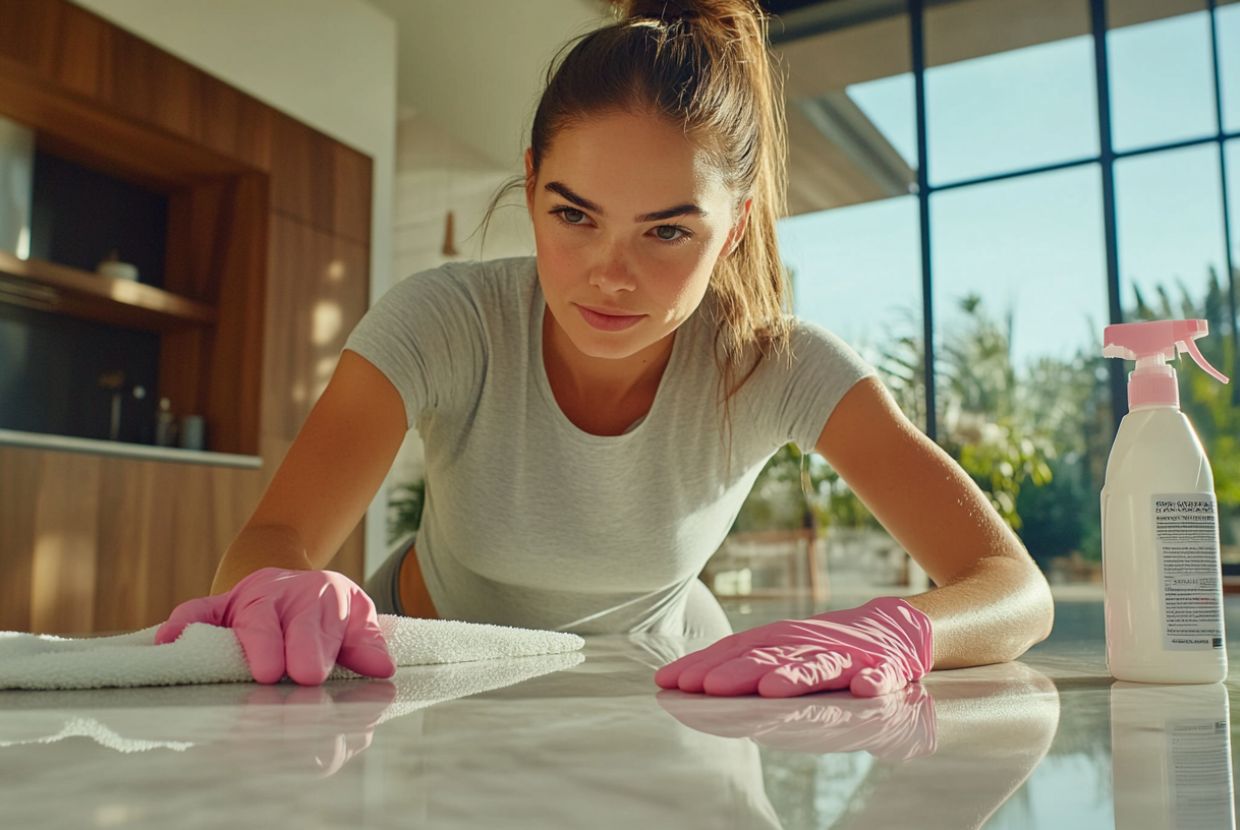Marble surfaces stand out for their high aesthetic value, as they enrich the look of any home. They have a charming, lustrous design, accompanied by extraordinary functionality. However, they are not immune to daily deterioration and wear. Therefore, learning how to polish a marble floor is essential for effective maintenance.
How to Polish a Marble Floor? Preliminary Steps
Cleaning and degreasing before polishing
Use a vacuum cleaner or a microfiber cloth to remove surface dirt from the pavement.
Mix warm water with a neutral cleaning product to remove any stuck-on residue.
Wait for the surface to dry and wipe it with a microfiber cloth.
In greasy areas, a mixture of liquid soap and warm water provides good results.
Inspection and treatment of stains or scratches
Once cleaning is complete, it is important to check the condition of the floor for signs of deterioration.
Stains or scratches can be treated with a paste of baking soda and water.
Homemade Methods to Polish a Marble Floor
Pre-cleaning with neutral detergent and warm water
Rub the mixture with a soft cloth, making sure it's clean before using it. This is one of the most effective methods if you're learning how to polish a marble floor with affordable resources.
Manual polishing with fine wool and microfiber cloths
With these materials, you can remove stains and residue, restoring the shine noticeably. However, manual polishing is only recommended if the surface is not damaged.
Commercial polishes: advantages and limitations
Commercial polishes are a good option for those looking for quick alternatives to polish a marble floor. They improve the floor's appearance and protect it from wear and tear.
However, some contain abrasive compounds that can affect the surface if not used properly.
Precautions
Do not use cotton mops, as they leave moisture residue.
Avoid rags or sponges with oily products, as they can cause stains.
Remedies such as vinegar or lemon are too acidic and can damage the marble.
Using only water to clean can dull the surface's shine.
How to Professionally Polish a Marble Floor?
Differences between polishing, crystallizing and shining
Learning how to polish a marble floor isn't the only way to care for it. Polishing and crystallizing also offer excellent results, as they improve the floor's aesthetic appearance and protect it from wear and tear.
Personalized inspection and diagnosis
It's essential to assess the condition of the marble to apply the most appropriate treatment. Inspect all areas for visible damage or potential problems.
By understanding how to polish a marble floor, you'll be able to make a more accurate diagnosis and apply the most effective treatment.
Polishing phases with diamond discs and specialized machinery
Preliminary evaluation of the floor condition.
Application of discs with diamond particles.
Polished to remove stains and scratches.
Sealed to increase the strength and durability of the marble.
Application of crystallization for extra protection
The crystallization acts as a waterproof layer that prevents stains, moisture, and cracks. It also offers anti-slip properties to improve safety in high-traffic areas.
Comparison: Do It Yourself (DIY) vs. Professional Service
Finish and duration of treatment
Professional services guarantee a long-lasting finish. Homemade methods are useful for basic maintenance, but they won't fix deep damage.
Time, cost and guarantees
Hiring professionals requires a greater investment, but it saves time and effort. They also usually offer guarantees if the result is unsatisfactory.
Material safety
If you're inexperienced, it's best to leave the job to experts. This will prevent damage to the marble and preserve its integrity.
Maintenance After Polishing
Daily cleaning (neutral detergent and soft cloths)
It's recommended to use microfiber cloths with a neutral detergent. Then, wipe with a dry cloth to avoid moisture.
Periodic polishing: when and how
Due to their porosity, marble floors require light polishing every three months. Use appropriate products that won't damage the surface.
Tips to avoid stains, scratches and loss of shine
Do not use abrasive products.
Clean up spills immediately.
Place rugs in high-traffic areas.
Check the condition of the floor regularly.
Keep a cleaning and polishing schedule.
Frequently Asked Questions
How often should a professional polishing be done?
It is recommended at least once every 6 or 12 months.
Can I combine home methods with professional polishing?
Yes, it's recommended for better floor maintenance. By knowing how to polish a marble floor, you can apply more effective regular care.
What guarantees do polishing and crystallization services offer?
They provide a protective layer that prolongs the life of the marble and maintains its original shine.
At Projectes Sastre we are specialists in floor polishing and vitrification in Mallorca.
Maintaining the shine of marble doesn't have to be complicated or expensive. At Projectes Sastre, we take care of the surfaces in your home with modern and effective techniques: polishing and vitrification in Mallorca .
We specialize in professional floor treatment to preserve its appearance and functionality. Contact us today for a quote and to schedule an appointment.




